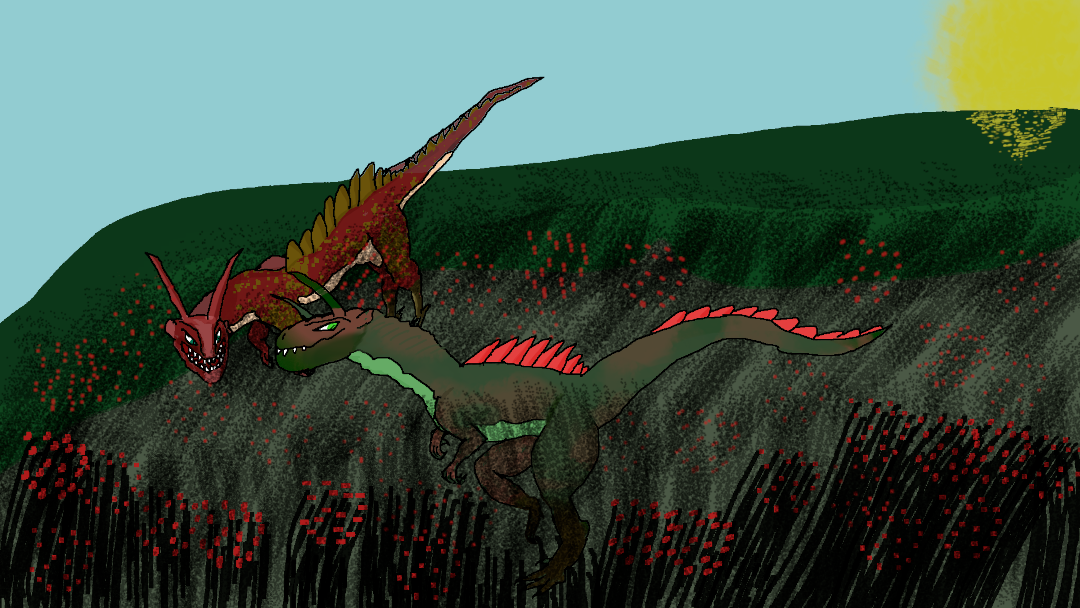Tiktiks
Can I keep her? Please, please, please?Tiktiks are small, green and red raptor-like species living in groups of four to twenty individuals. Their comparably small size and dog-like intelligence makes these creatures possible to tame down and raise as pets, although they can also be extremely difficult to keep in one place. Whenever Tiktik, no matter how well-raised encounters other wild Tiktiks, there is a very high chance that it will join them and flee from their owners permanently. This usually means that Tiktiks raised as pets should be kept as far away as possible from forests.
5-year old Sayeth who brought a Tiktik back home
Basic Information
Anatomy
Tiktiks move thanks two muscular and long hind legs, their stance near-upright. Long tails enable them to maintain balance even throughout high-speed sprints, whereas their smaller foreclaws are generally not used for movement at all, but they help this predator catch onto their prey to slow and ultimately bring it down. Many razor-sharp teeth protruding from their elongated muzzles are more than capable to severely injure or kill when they latch onto their target.
These raptor-like creatures are commonly found in various shades of green, brown and black. Eyes are serpentine with yellow or red iris. Albinism within this species is very rare.
Genetics and Reproduction
Both sexes enter a brief period of fertility every time both Moons are full. Females lay 3-4 eggs after two weeks of gestation. Tiktiks of the group use shared hatcheries which they do not protect but they make sure it is as well-hidden for the duration of about 40-50 days before the eggs hatch. Only 25% of all Tiktiks are females.
Eggs conceived during month of Freezan are stored underground but tend to have very low survivability.
Growth Rate & Stages
Male Tiktiks reach adulthood within one year, females within year and a half.
Ecology and Habitats
Forets, tundras, jungles. There are slight variants to the species which are bigger or smaller but they all are carnivores/scavengers. The most common ones are Forest tiktiks.
Dietary Needs and Habits
Tiktiks primarily prey on smaller beasts or bigger herbivores. Their hunting tactics involves surrounding their prey and attacking at the same time to overwhelm it. If threatened, Tiktiks focus their attention on the greatest threat first, before they start attacking weaker individuals.
Additional Information
Social Structure
Males tend to be leading Tiktik groups, although rarely a female has been observed as well. Some rudimentary communication and information sharing is conveyed to the current leader who decides what to do. The current Alpha (be it male or female) and their mate tend to be on top of the group hierarchy.
Domestication
Must be performed from egg or very young age. Adult Tiktiks are impossible to tame. Tiktiks are loyal to their domesticator until they encounter other Tiktiks. It is recommended to keep domesticated Tiktiks as far away from the wilderness as possible or bring them to a place from where they cannot escape.
Uses, Products & Exploitation
Eggs of Tiktiks are considered a rare delicacy, yet taming them is difficult, time-consuming and generally requires raising the chicks from their eggs. Still, some dragons attempt to farm these animals, in various degrees of success.
Geographic Origin and Distribution
Amongst forests and swamps of the Continent. This species tends to avoid mountainous areas or areas without a canopy in general.
Average Intelligence
Capable of limited communication within their groups. Dog-like intelligence when alone, Dolphin-like intelligence when in large numbers.
Perception and Sensory Capabilities
Great sense of smell. Capable of limited communication amongst its group.
Scientific Name
Midrast Tiktikulanus
Lifespan
18 years
Average Height
1 m
Average Weight
26 kg
Average Length
2.2 m
Average Physique
Lithe, muscular
Body Tint, Colouring and Marking
Spotted or mottled red markings, rest of their scaled form is green, brown or black.
Remove these ads. Join the Worldbuilders Guild









Comments